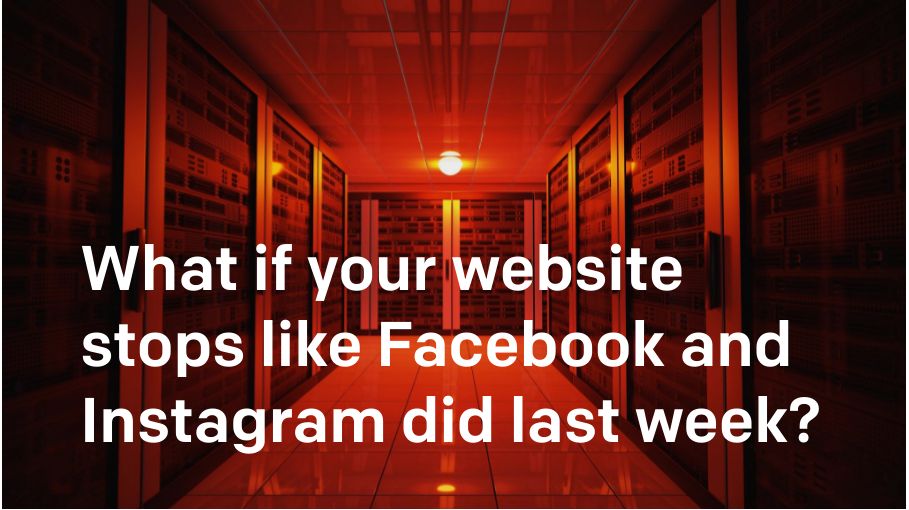What Happens if your Website Stops The Way Facebook and Instagram Did?
The mighty has fallen! Discover how screenshots can help your business in diverse ways in the case of a service outage, just like Facebook.

Recently, we all experienced one of the worst technical outages with Facebook and its family of applications, including Instagram and WhatsApp, were out of reach for hours. It severely impacted billions of people around the world. The significant effect was on people not being able to communicate with their friends and relatives, but it also led to more negligible domino effects such as people not being able to continue with social logins on their Smart TVs or shopping sites.
Though many of us remained untouched by the crash, it did raise a question in the minds of a few, “What would happen if the same happens to one of my dynamic business websites?” Facebook lost $6 billion in shareholder value during the outage; hence the immediate logical conclusion was that such outages have a huge monetary impact.
This incident should be an eye-opener as it shows that if the most powerful giant can stagger in just a few minutes, why can’t your website? Therefore, being future-ready is the need of the hour.
You might have heard about screenshot software used to capture your screen activity in the form of images—wondering why I am talking about this here? Screenshots can come to your rescue when your website stops, and there is no way to bring it up before hours. Various screenshot applications are designed to capture, archive and share the screen images without human intervention. Furthermore, you can manage and schedule them to capture screenshots of the set URLs in a predetermined frequency.
Again, the question arises of how these screenshots will help me in the case of a breakdown? Let us take an example to understand it better. Suppose you own a travel portal and the server goes down for a few hours, your customer support will be queued with calls, and there will be tremendous chaos. Here, if you have been regularly archiving your website’s screenshots, you can use them at least to show information about travel plans, places and other static details. Or let’s assume you own an eCommerce company, now you have been highlighting dynamic discount coupon codes to your repeat customers. If the coupon code generating functionality suddenly crashes, you may have angry customers calling you for their discounts. This is where a screenshot software can help you; the support teams can look at the archive and find out which coupon code has been shown to them and the discounts can be processed subsequently.
The use of screenshots is not limited to mitigating the adverse effects of service breakdowns; you can also use them for other purposes, including:
- Showing exactly what you mean – When relevant screenshots back up your demonstration, it becomes more meaningful and easy to comprehend. For example, it may comprise the official rules and procedures for the employees, or showing the product details to a customer during a breakdown or explaining to the students about the exam procedure.
- Social Media Posting – Do you sometimes find a superb, funny or memorable comment, tweet or post? Is it always feasible to rewrite or recreate it? Definitely not! You can just take a snapshot and create your version of the content.
- Show error messages – Screenshots of error messages help in providing an exact picture of the problem. The IT or the support team will be able to know what exactly is going on. A screenshot saves effort and provides complete information about the error to the concerned person.
- Monitor your website – Using a screenshot software, you can easily define website URLs and other options like time and frequency of screenshots to be captured. This not only helps you to keep an eye on the portal’s functionality, but you can also use the archive at the time of breakdowns, as we have discussed earlier. Also, the internal systems can be seen in action, and any flaws can easily be detected.
Putting it straight forward, screenshots are a critical part of any business and the life of a general user.
They are great marketing material too. For example, adding screenshots to your blog makes it more enjoyable to the user, and using them on a social media post to prove that your software is really “easy-to-use”, makes the post memorable.
Let’s also understand it a little differently. Screenshots are your version control. For example, your office has a new lateral joinee; you would want them to understand the progress of your projects without immediately giving them access to all the projects in one go. Instead, you can provide them with screenshots of where the projects have reached and the new tasks lined up.
Although they may seem simple, the power of screenshots is limitless. They can save you in crucial situations like service breakdowns or power cuts and serve as an alternative to the dynamic world. In addition, they are a great way to do your repetitive tasks like demos and training easily. Images and videos made out of screenshots can serve the purpose.
Now addressing the second part of your question—How do you select the best software in cases like these? Stillio comes to your rescue! Stillio is the “easiest to use” screen capture software that can take scheduled and ad-hoc screenshots for you. You can use them for trend analysis, competitor analysis, or, as this blog describes, content verification.